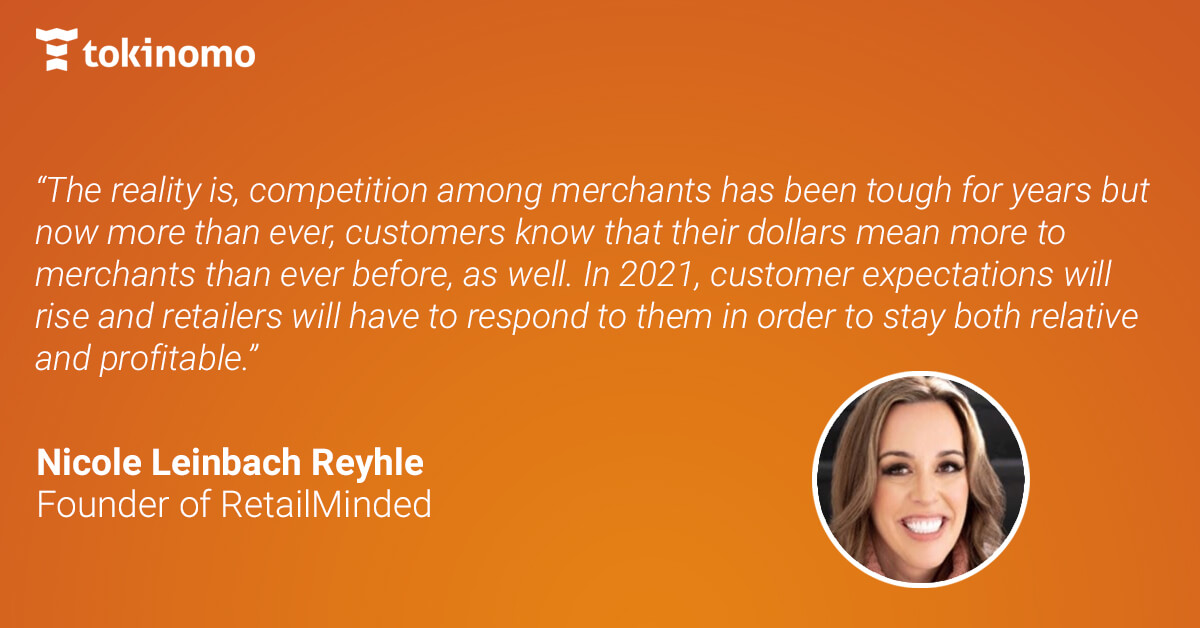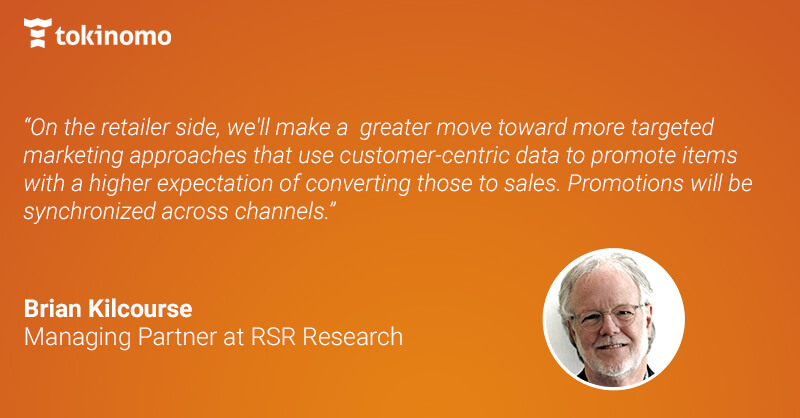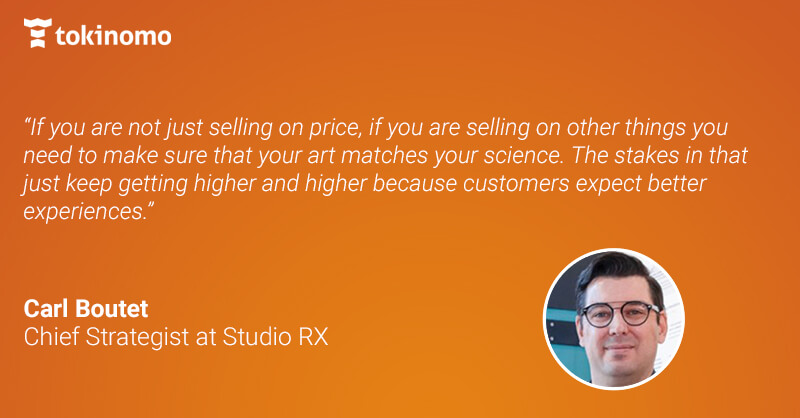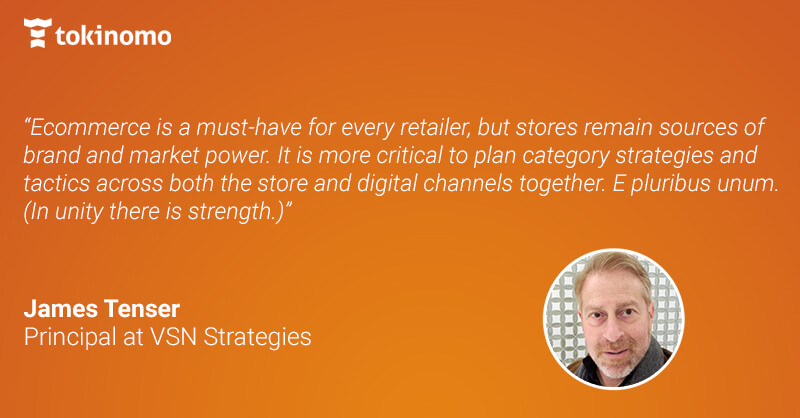Retail is changing as we speak. COVID-19, the iceberg that hit the whole retail industry is slowly (too slowly) melting away, but its effects will continue to impact this industry for many years. Innovations, retail tech, providing only the best for customers, offering shoppers amazing experiences, and availability on all channels are all impacting the way retailers sell to customers.
In this round-up, we gathered some of the most influential voices in the industry to tell us what to expect in 2021 when it comes to in-store marketing.
Are in-store marketing tools effective? Is shopping in-store an experience of the past?
Let’s find out the answers to these questions and many others from retail experts!
What 2021 has in-store for in-store marketing
We all love trends and we want to know ahead of time what is going to happen so that we have time to prepare. That’s why we wanted to know what retail experts predict for in-store marketing in 2021.

“In 2021, I believe retailers will need to up their customer service while still keeping in mind social distance best practices. After all, why should customers choose one store versus another? Customer service and customer experience both will begin to mean more than they ever have before to consumers.
Beyond price, these details will influence customers in regards to where they choose to shop. The reality is, competition among merchants has been tough for years but now more than ever, customers know that their dollars mean more to merchants than ever before, as well. In 2021, customer expectations will rise and retailers will have to respond to them in order to stay both relative and profitable.”
Nicole Leinbach Reyhle, Founder of RetailMinded
Retail tech is starting to make its mark in the industry and without it, brick and mortar retailers risk losing in front of the competition. Brands are also starting to rely on technologies such as Tokinomo to better promote their products.
“In-store marketing will become quite important as pent-up demand for store shopping is potentially unleashed after vaccines rollouts. Technology will factor in much more heavily as stores evolve into fulfillment centers for online orders. Retailers will leverage high-tech solutions to drive high-touch experiences.
Simulation technologies powered by augmented reality will replace human-to-human contact in high-touch categories such as beauty. Retailers will make advanced decisions regarding which products and categories are better suited to the store environment and which ones can be more efficiently sold online. Sustainability efforts will go to the next level, not just with products but also total store operations.” - Carol Spieckerman, President of Spieckerman Retail
Apart from adopting new, innovative in-store marketing technologies, retailers have started to move their promotions on digital platforms, apps, and websites. Noticing the constant need for customers to be present online made retailers think twice before keeping their store 100% offline. Omnichannel stores are the future and synchronizing marketing and promotions on all channels is mandatory.

“While consumers are shifting toward digitally delivered coupons as younger generations become routine shoppers, traditional tactics have remained important – but the approach to planning their design and evaluating their performance must evolve. CPG companies (who often fund promotions) are shifting their emphasis towards digital marketing. On the retailer side, we'll make a greater move toward more targeted marketing approaches that use customer-centric data to promote items with a higher expectation of converting those to sales. Promotions will be synchronized across channels. “
Brian Kilcourse, Managing Partner at RSR Research
Customers want more from retailers because they got used to receiving personalized experiences and that’s the direction in which brick and mortar retailers should be moving.
Retailers, remember one thing: Shopping online doesn’t provide the same experience and that’s why more and more people are going to come back to the store after the pandemic passes.“I think in-store marketing campaigns are going to be more contextual, personalized. All while respecting privacy, but as an opt-in, they are going to be more important in the overall marketing mix because the most value can be created in the store which is clearly the experience, not the access to the product. With the pandemic we’ve learned how to find products in many different ways.
We see this whole eCommerce adoption but that does not reduce the importance of the store. It is always going to be a point of media and in-store marketing makes that point of media much more critical.”
Carl Boutet, Chief Strategist at Studio RX
“The shift to digital that was accelerated by the COVID-19 pandemic in the past 12 months naturally raises questions about the ongoing relevance of the store. Not to worry – even as more shoppers buy a greater proportion of their goods online, stores remain the primary selling channel – for most categories.
Certainly, a larger share of promotion budgets will be transferred from stores to digital, but brands still battle it out at the shelves, displays, and garment racks. If trips become less frequent, then the effectiveness of each in-store encounter must improve. The wild card will be linking in-store with digital experiences via mobile devices – still very much an area of experimentation.”
James Tenser, President of VSN Strategies
In-store promotions tools - Are they effective?
There is a saying: “Don’t bring a knife to a gunfight.” While this might seem like a violent game of words, it shows the importance of having the right tools for the right job. If retailers still rely on old-school in-store promotion tools, they are playing a losing game.
So, are today’s in-store promotion tools effective?
“It depends on the retailer. Some are relying more on people-powered processes while others are looking into digital displays and even robotics. The efficiency of retailer’s in-store marketing tools relies on integration, particularly the ability to integrate online and offline processes and inventory visibility.”
Carol Spieckerman, President of Spieckerman Retail
“In-store digital media continue to vie for respect in the retail environment. They seem to have plateaued in the food-drug-mass sectors, but there is plenty of creativity at work in the department store and specialty sectors. Mobile phone retailers have been especially active with video walls that may be incorporated into the store design in some instances.
Designer apparel brands have built them into their department store boutiques. Once screens are installed, there may be some efficiency gains when it comes to updating the digital content, as compared with hanging posters or even dressing mannequins. Some systems are actually capable of measuring views and interactions using built-in sensors.”
James Tenser, President of VSN Strategies
Robots, digital POP displays, and augmented reality seem to be the next step for in-store promotions in brick and mortar stores. But what about funding?
“Promotions have been dependent on funding from CPGs to fund offers that yield the “lowest” – not necessarily the “optimized” – price. To create incentives for consumers, Fast-Moving-Consumer-Goods (grocery, drug, convenience) retailers, in particular, have depended heavily on CPG vendor-funded promotions and loyalty programs to drive traffic. But the evidence is that the resulting promotions don’t increase loyalty, and the redemption rates are not very high - usually measured in single digits.”
Brian Kilcourse, Managing Partner at RSR Research
What is the main struggle for brick and mortar stores when it comes to in-store promotions? Data! While eCommerce platforms know exactly what their customers like, want, and need, brick, and mortar retailers had a hard time gathering data in the past. But what about in 2021? Is customer data still a problem?
“Data is a huge influence on in-store marketing and fortunately, it's available in many ways. From foot traffic counters such as Dor Technologies that influences merchandising, marketing, and staffing alike to technology-enabled platforms that manage CRM including loyalty programs such as Lightspeed POS to technologies that allow stores to use their physical locations to highlight inventory via video then capture sales online such as CommentSold, there are so many ways to gain data and increase efficiency as a result.”
Nicole Leinbach Reyhle, Founder of RetailMinded
In-store, online, or hybrid?
For thousands of years we’ve only shopped in person, in-store -or a cave, a market, and now a shopping mall-, but now shopping no longer means walking to a facility and purchasing products. It’s much more than that. Shoppers are no longer coming to the store, the stores are coming to them on every possible channel.
“We will be living in an “all of the above” world where retailers will need to provide multiple convenience options and shopping alternatives to ensure that shoppers remain in each retailer’s ecosystem. Convenience and choice are synonymous in retail these days and retailers have learned that they can’t afford to curtail choice.”
Carol Spieckerman, President of Spieckerman Retail
“It’s a mix. They are not mutually exclusive. The race to resilience it’s all about embracing the blur between the physical and the digital. We are just going to get there more quickly than we thought due to the pandemic. These equations are not sustainable on their own. It’s how they complement each other. The answer is both, depending on the consumer. The most typical will be a digitally-enabled physical world and, maybe, we would eventually get to a physically-enabled virtual world.”
Carl Boutet, Chief Strategist at Studio RX
“Shoppers will likely maintain most of their new online shopping habits in the year ahead, but I would not anticipate expansion of those behaviors at anywhere near the rate we have just experienced. Many will welcome the opportunity to shop again in well-appointed stores on those occasions when it suits them. They will choose among channel options on each occasion according to their momentary needs or shopping missions.
I have never been a great fan of pick up in-store, but I believe curbside or drive-thru pickup models are likely to have lasting appeal, as retailers learn how to streamline those experiences and link them with superior digital purchasing platforms. Steep challenges remain with regard to implementing pick up models in shopping malls because they are literally not built for it.”James Tenser, President of VSN Strategies
Being present on all channels is mandatory in 2021, but where do shoppers actually prefer to shop?
“The evidence is compelling that consumers increasingly begin their shopping journeys in the digital domain even when they expect to finalize their shopping journeys in a store. In 2020 RSR conducted a consumer survey that indicated that 94% of consumers in the US believe that online shopping is a necessity during the COVID crisis, and 45% believe that starting their shopping journeys in the digital domain will be a “necessity” going forward.”
Brian Kilcourse, Managing Partner at RSR Research
If customers start their journey online, are brick and mortar stores still relevant?
-jpg.jpeg)
“The majority of shoppers continue to visit physical stores, but the impact of COVID-19 has made online more prominent. Our research has found that many of the newly acquired online shoppers from 2020 intend to stick with the channel in 2021. Given the ease-of-use and flexibility of online, browsing and shopping around is more likely to increase.
More competition will mean retailers and suppliers will have to work hard to retain shoppers; developing attractive omnichannel loyalty schemes could help keep shoppers both online and in-store. Shoppers will also expect continued innovation in the channel, so differentiation will be key in 2021. And, they will require more than a transactional service, so retailers and suppliers will need to focus on supporting their customers, whether it be with sustainability, health, or category-specific advice.
Click and collect will continue to be more prominent, driven by ‘stay at home’ guidance. In terms of in-store, the trend for less frequent “weekly shopping”, again driven by COVID-19, is likely to continue for the foreseeable future, but we’re likely to see a trend towards more frequent “top-up” shopping towards the end of the year, with the roll-out of vaccination programs and the easing of restrictions.”
Ellie Tew, Shopper Insight Analyst, IGD ShopperVista
The impact of COVID-19 on in-store marketing
One of the biggest challenges retailers are facing is the impact of COVID-19. Some retailers even went out of business, non-essential stores were closed for weeks on end, and people were reluctant to come inside stores at the peak of the pandemic. What comes next? Is COVID-19’s impact going to change the way promotions are done in the next few years?
“COVID will forever influence both retailers and consumers because it demanded immediate change from both sides. Retailers had to shift gears to stay connected to consumers while consumers had to often step outside their own comfort zones to continue their shopping journeys.
New ways have and will continue to be introduced when it comes to shopping, but it won't entirely change the shopping experience. It will simply transform it, but then again hasn't commerce always been transformed? That's simply what time does.” - Nicole Leinbach Reyhle, Founder of RetailMinded
“Food sampling is just about DOA this year and there are severe obstacles to its return. Even after the “all clear” is sounded, many shoppers’ attitudes about sanitation have been altered in an enduring way. Anticipate much more stringent rules and practices if it comes back at all.
Club stores and those food stores who relied heavily on sampling prior to the pandemic will benefit from a hard analytical look at new product trial statistics from the past 12 months. This may enable a fresh evaluation of the value of sampling. Where it is discontinued, brands will likely seek avenues to re-purpose the promotional funds to more acceptable uses – pre-pack displays might be an option for non-perishables. Prepared food items will be much tougher.” - James Tenser, President of VSN Strategies
Understanding the needs of shoppers and constantly improving processes and products to meet those needs is the essence of true retail.
“It all goes back to choice once again. Retailers shouldn’t play guessing games or attempt to generalize about shopper behavior or motivation. Some shoppers will remain concerned about the cleanliness and dwell time in stores. Others will quickly get back in the swing on all facets of the physical retail experience. Retailers will need to address the full spectrum of shopper need states.” - Carol Spieckerman, President of Spieckerman Retail
“Obviously it’s going to impact on the long run. We’ve seen the statistics, seen the data. The huge digital adoption during the first wave of the pandemic wasn't sustained. People got back to stores so it’s not like a no turning back scenario. But we do know - if we just use rough numbers- we were at 15% online shopping pre pandemic and it went up to 30% online during the pandemic in a lot of the markets. Not talking about China which is over the 50% mark. Now it’s settled back down to around 25% depending on categories and certain regions. It didn’t go back to 15%.
Sampling will come back for example. It’s not a question of if it’s gone forever. There is going to be more consciousness around the safety and the sanitary measures around it. I think that it will be introduced in a different format, depending on where you are in the world.“- Carl Boutet, Chief Strategist at Studio RX
Brick and mortar stores struggles
Both brick and mortar stores and eCommerce platforms want the same: please customers and increase revenue. However, they are working with different tools, have different tactics, and take different approaches.
What are the main struggles brick and mortar stores have when it comes to marketing?
“It’s all about understanding the customer and having the data points that help you understand. It’s important to collect that data in a way that respects privacy while making your in-store offer relevant and personalized. That’s the big challenge. It’s not a new challenge, it’s been around for 20 years as eCommerce is evolving and it’s inspired a lot of technology that we see in stores to try to better capture the data around the customer journey. This is still a challenge and the pandemic didn’t really help that. The businesses just increased their investments in virtual channels so it’s going to be very important to calibrate and to adjust for the physical ones as well.” - Carl Boutet, Chief Strategist at Studio RX
Everything comes down to data once again. Now knowing who your customers are, makes it almost impossible to market to them. Without understanding their needs, it’s hard to know what to offer.
“In-store retailers struggle to simply get attention from their customers because often their customers are not immediately near their stores. This is a challenge, but it's not impossible to overcome.” - Nicole Leinbach Reyhle, Founder of RetailMinded
Just because customers are not always around physical stores does not mean brick and mortar stores shouldn’t make efforts to market their products. It just means that retailers should think of an omnichannel approach in order to always be present and top of mind for shoppers.
“Digital recommendation engines and reviews are two powerful tools that are difficult to replicate in-store. The former is more easily accomplished than the latter through innovative, cross-category merchandising. In the past, retailers have attempted to bring purchase reviews in-store without much success. All forms of “search” are simply easier to accomplish online. Dynamic pricing is also much more easily executed online than in-store and yet another capability that retailers are cautiously testing with varying success.“ - Carol Spieckerman, President of Spieckerman Retail
Try, verify, adapt! These are the steps to a successful business, even in the retail industry. Brick and mortar stores should always experiment with new tactics to promote their products to shoppers.
“Beyond access to capital, the next biggest challenge for chain retailers is inventory accuracy and visibility. While a pure eCommerce retailer may have just a handful of fulfillment centers to track, a chain with hundreds of stores faces a massive and ongoing challenge to maintain the right stock levels for every item in the assortment at each location and keep continuous track of the inventory. Too many units in the wrong locations results in overstocks which cause shrink and markdown while harming cash flow. Too few units results in missed sales opportunities, or out-of-stocks, which also undermine the shopping experience.
Inventory optimization competency may not seem like a marketing problem, but in fact, it is essential for understanding the true demand signal as well as the ability to forecast and evaluate promotion response. I believe it is a golden secret of the few best merchants.”- James Tenser, President of VSN Strategies
Innovation: The foundation of a successful business
More and more retailers are starting to see the benefits of using innovative retail technologies such as in-store marketing robots like Tokinomo, augmented reality, and VR. However, most brick and mortar retailers are still reluctant to innovate. This is why we wonder how stores are going to innovate in 2021.
Retailtainment seems to be the buzzword that every retailer should be talking about in 2021. However, some retailers still don’t have the necessary resources to focus on experiential retail.“Stores will continue the trend to be more “experiential” - more localized assortments, presentations, and in some cases even price and promotions. Higher levels of customer service will be critical, as consumers shift more towards the store as a place where a purchase is finalized and fulfilled rather than a place where demand is first triggered. Retailers will stop thinking so much of “digital” and “physical” as different channels, instead of thinking of them as a synchronized “selling environment”.
Loyalty programs will become a “must”, and promotions will be based on propensity to buy as determined by market basket analysis in order to optimize promotional plans. Retailers will increasingly leverage artificial intelligence to help retailers identify customer behavioral patterns and match those against modeled behavioral patterns to predict the efficacy of promotional plans, optimizing promotional spend and making each investment more efficient and effective.” - Brian Kilcourse, Managing Partner at RSR Research
“2021 is still a transition year. I think that 2022 will be more interesting. 2021 is still about the aftershock. The more prograsive retailers already made investments to optimize the store for distribution. They are doubling down and they are putting back money in-store because they recognized that the stores can provide experiences which helped retailers increase revenue. A lot of other retailers are going to focus on experiential retailer in the future, but not everybody is well resourced because that’s what the pandemic did: the retailers that were doing well are now doing much better while the others are struggling even more.” -Carl Boutet, Chief Strategist at Studio RX
-jpg.jpeg)
"Brick and mortar shops are primed for innovation in 2021. The pandemic has forced retailers to think in new ways. The shift to online shopping will naturally increase in-store innovation as store-level fulfillment and other capabilities expand in response."- Carol Spieckerman, President of Spieckerman Retail
“With online shopping remaining at an elevated level, in-store order fulfillment and order staging know-how is due for a major upgrade. Two major classes of solutions are needed – one for specialty stores which tend to have fewer than 5 items per order packed for shipping, another for grocery and mass merchants which may have orders with as many as 50 or more items with varying temperature requirements prepared for pickup or delivery.
Another important innovation area is the localization of assortment and promotion. The best national chains already implement regional mixes of colors, sizes, and styles in apparel. Grocery chains often stock different brands and foods according to local preference. These practices can be enhanced further by employing AI prescriptive analytics to guide decisions down to the store level.
The availability of “long tail” digital assortments can enable stores to fulfill more variety of shopper needs even with more tightly-edited store assortments.” - James Tenser, President of VSN Strategies
Final thoughts for brick and mortar retailers
We thank all of the experts for sharing their knowledge with us and we’ve asked them to provide a few final pieces of advice for retailers that want to grow and offer the best to their customers. Let’s see what the experts advise:
“Retailers have been trapped in a cycle of never-ending mass promotions for a long time; in fact, RSR’s research has revealed a steady increase in promotional activity in the last decade. But those promotions haven’t succeeded in winning long-term customer loyalty. Retailers clearly understand that their continued investment in price reductions isn’t a winning strategy, nor is it something that can go on forever.
Instead, investment in solutions that enable focused and highly relevant offers to consumers promise to lower the overall level of investment of promotional monies while improving the effectiveness of that spend. The result will be competitive differentiation, greater customer loyalty, and improved profitability for promoted items.
There are better options available to retailers and their trading partners; promotional programs can better target spending on those offers that will be most relevant to consumers – thus driving loyalty.
Personalized promotions can be tuned to the customer, their preferences, their propensity to buy, and the basket size that accompanies certain promoted items. Well-designed programs make it easier for consumers to redeem than to ignore (unlike mass promotions). And finally, personalized promotions are difficult for competitors to copy since they are dynamic and one-to-one.” - Brian Kilcourse, Managing Partner at RSR Research
“Smart retailers will focus on creating compelling merchandising for the higher-margin, discretionary categories that have struggled during COVID-19. Focusing on driving cross-category purchases should be a top priority. Even if shoppers return to stores in droves, retailers will still need to focus on convenience and making it easy for shoppers to spend less time in stores.
Even though so much depends on successful vaccine rollouts and managing emerging virus strains, retailers should move ahead with building out touchless shopping, payment, and checkout options. The good news is, retailers have never had more options for filling in gaps using third-party providers and strategic partnerships. They don’t have to build everything internally, yet sitting on the sidelines isn’t an option.” - Carol Spieckerman, President of Spieckerman Retail

“They need to strengthen their data science bench. Make sure they have the skill and get better at collecting data the right way and know what to do with it so it optimizes the customer journey. That’s one of the big pieces of advice I can share with them. Data science is a pretty big talent gap right now in the industry. To track that talent is not easy so retailers have to increase the efforts around that.
However, they shouldn’t make everything about data. It’s important to focus on the emotions of customers as well. They need to make sure that they craft marketing campaigns that are engaging and meaningful, add value, and create moments of delight. Especially if this is part of your value proposition. If you are not just selling on price, if you are selling on other things you need to make sure that your art matches your science. The stakes in that just keep getting higher and higher because customers expect better experiences” - Carl Boutet, Chief Strategist at Studio RX

“Number one, don’t take your eye off the partner that brought you to the dance in the first place. If the bases of your business, your brand, and your shopper loyalty are in brick-and-mortar stores, do not neglect them while you race to upgrade your digital and omnichannel competencies. Ecommerce is a must-have for every retailer, but stores remain sources of brand and market power. It is more critical to plan category strategies and tactics across both the store and digital channels together. E pluribus unum. (In unity there is strength.)” - James Tenser, President of VSN Strategies



